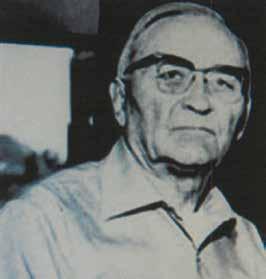
5 minute read
A short history of pivot irrigation
This section brought to you in association with
FRANK Zybach was born in Oregon in 1894. His family moved to Nebraska later that year. He began farming, but enjoyed inventing and designing much more. And invent he did – he is credited with designing and building what would become the first centre pivot in 1948.
Advertisement
Apparently, he got the idea after seeing a poorly done irrigation demonstration in 1947. On the way home he remarked to his friends, “There has to be a better way to irrigate.” Frank started on the first ‘self-propelled sprinkling irrigation apparatus’ system later that year. His original pivot swung around on a set point, sprinkling water over the crops. It was also only about four feet tall and got stuck easily. He said the hardest part about making it was keeping the towers aligned.
In the years that followed, he modified and refined the design to improve operational efficiency.
The patent
The pump was placed at the centre of the field next to a well, irrigation pipes supported by trusses were mounted on wheeled towers that could make a circuit of the field under their own power, leaving that distinctive circle pattern. Gun-style sprinklers sprayed water out from the pipes at set intervals, with smaller nozzles closest to the pivot and the largest nozzles at the end of the line. The system could cover 133 acres of a 160-acre field - a quarter of a one square mile farming section - and didn’t have to be disassembled by workers when it was time to plant, till, or harvest.
Frank was issued a patent for his invention in 1952. He and his partner, A.E. Trowbridge, attempted to sell the systems in the local area for two years. Farmers being farmers – they were a tad sceptical and were reluctant to invest
Frank Zybach, inventor of the first ‘selfpropelled sprinkling irrigation apparatus’.
in this innovation.
But there was a business man on the lookout for investment opportunities.
Born in 1922 in Omaha, Nebraska, Robert B. Daugherty was a graduate of Central High School in Omaha and Carleton College in Northfield, Minnesota. After graduating from Carleton in 1942, Daugherty served in World War II. He was commissioned a second lieutenant in the Marine Corps, first serving in the Pacific Theatre, and later in China.
After the war ended, Daugherty was considering a career in the Marines until his uncle and mentor, Frank Daugherty, convinced him to consider post-war business options.
Robert recognized the potential of a small manufacturing company on a farm just west of Valley, Nebraska, owned by an inventor named Sam McCleneghan. After careful consideration,




This section brought to you in association with
Daugherty invested $5,000 – nearly his entire life savings – to acquire a half interest in the Valley machine shop that produced built-toorder grain elevators for area farmers – Valley Manufacturing was born.
In 1954, Frank Zybach licensed his patent to Robert Daugherty. Valley Manufacturing engineers spent the next decade refining Zybach’s innovation – making it sturdier, taller and more reliable – and converting it from a hydraulic power system to electric drive.
In the 1960s, Valley Manufacturing became Valmont Industries and in the 70s, the company

Valley Manufacturing engineers spent a decade refining Zybach’s innovation – making it sturdier, taller and more reliable – and converting it from a hydraulic power system to electric drive.

Photos courtesy of Valmont Industries. For more information: www.valleyirrigation.com or www.smithsonianmag.com
n
EDITOR’S NOTE…
In the late 1970s our family was farming in North West NSW, 100 kms west of Moree on the Mehi River. Like others in the area, we had a water licence and were looking for an efficient and economical way to irrigate some 300 hectares of undulating country on the high bank of the river.
A neighbour purchased a Valley lateral move, the first in Australia we were told, and we followed a few months later. We were impressed with the potential of the machine but wary of how it would cope with the challenges of farming in that area.
We soon realised that the machine was built tough and could go virtually anywhere when it climbed up the bonnet of our neighbour’s Suzuki Sierra whilst he was working on another tower.
And although designed to operate on prepared wheels tracks, our machine handled our black soil/mud plains well – I never saw it bogged – I saw the wheels buried in mud in half-metre deep wheel tracks after sudden storms but the lateral just kept on moving down the block.
Challenges like strong hot winds that evaporated 80 per cent of the overhead sprinkler spray before it could reach the ground – well they were something else. We were impressed with the beautiful rainbow effect but not the application efficiency.
The Valley guys – always helpful – came out from the States to take a look – they too were surprised but not in a nice way.
We worked with them on a solution – we were sure there was one.
So now many, if not most, of the centre pivots and laterals in our part of Australia have drop pipes hanging from a u-shaped pipe attached at the top of the overhead delivery pipe – the sprinkler heads are positioned just above the crop. This markedly limited evaporative losses and wind drift.
As we moved forward, we worked with Valley tweaking various aspects of the machine. We got to learn a lot about irrigating in harsh environments. Within a few years we had a very efficient system that met our needs and helped pay off the farm, all this in the middle of a drought.
At one time we were the only property with green crops for 50 kms in any direction. Our place was a very popular feeding spot for all native and introduced fauna species – needless to say, we didn’t get much sleep.









